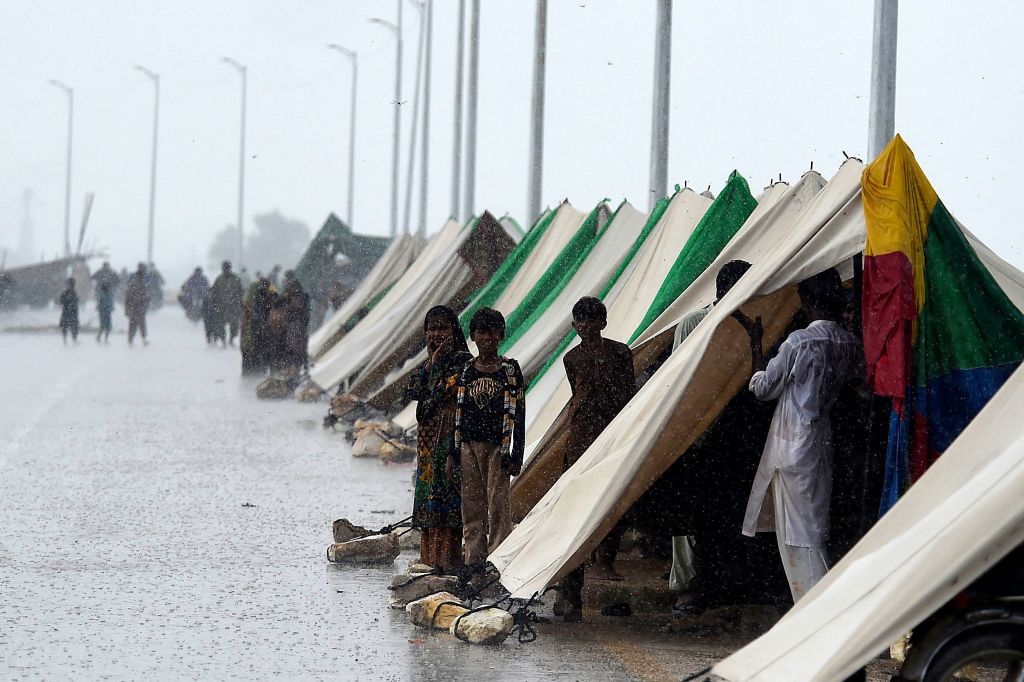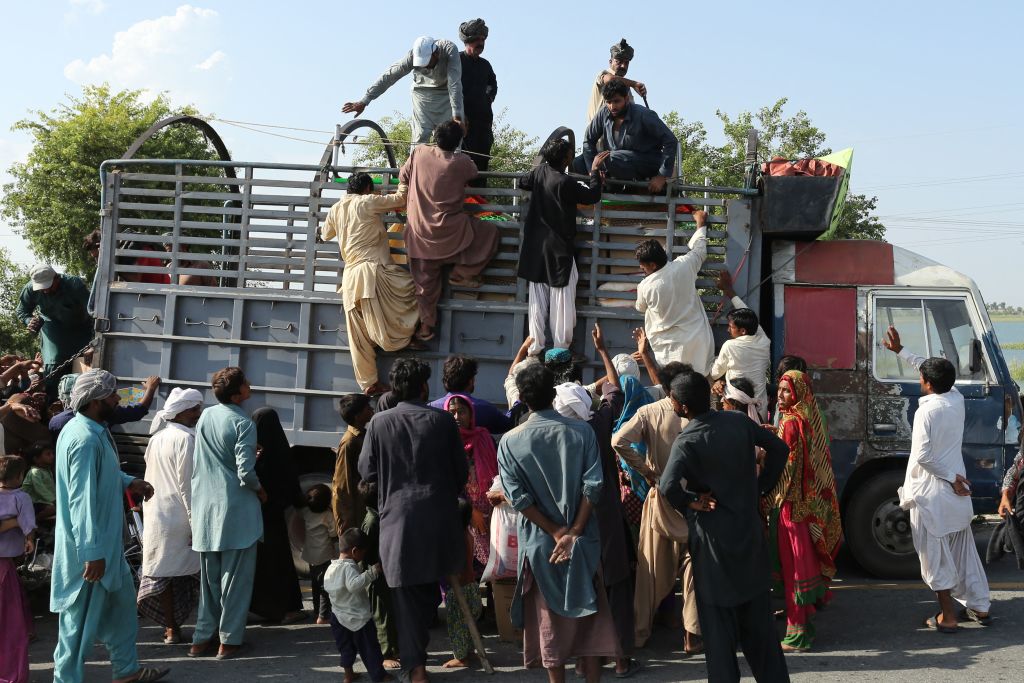Pakistan is grappling with its worst flooding in living memory. A staggering one-third of the country was underwater as of this week, with more than 30 million people affected over the last few weeks—killing at least 1,100 civilians and pushing almost half a million people into relief camps. U.N. Secretary-General António Guterres has referred to the disaster as a “monsoon on steroids” that “requires urgent, collective action.”
The immediate cause of the catastrophic floods is record rainfall. “So far this year the rain is running at more than 780% above average levels,” said Abid Qaiyum Suleri, a director at Pakistan’s Sustainable Development Policy Institute. Melting glaciers—Pakistan has more glaciers than any other country—is also contributing to the floods, which are linked to climate change.
It was only in 2010 when Pakistan last experienced such extensive floods but officials have already suggested that the damage from this year’s calamity is worse. That year, then-U.N. Secretary-General Ban Ki-moon had described them as the worst natural disaster he had ever seen—not just in Pakistan but anywhere in the world. The 2010 floods affected about 20 million people and led to more than 1,500 deaths.
The U.N. said Tuesday that it is seeking $160 million in emergency aid for the ongoing floods, noting that nearly 1 million homes had been damaged and more than 700,000 livestock were lost. The U.S. announced that same day it would send $30 million in aid to Pakistan. Humanitarian relief has started to arrive in the country, but efforts have been hampered by extensive infrastructural damage; over 2,000 miles of roads and 150 bridges have been affected.

Nauroz Jamali, a social sciences lecturer at LUAWMS University in Balochistan, has been helping with the volunteer effort in the southwestern province’s villages, including Gandakha. “This whole town has been converted into a dam with multiple sources of water pouring in but with no exit so it’s killing people feet by feet; it chokes us,” he says. Jamali adds that the floods had trapped his uncle, whom he helped eventually evacuate. “We are helping so many people with little manpower and we are in such a confused state. We don’t know what to do.”
Building climate resilience
Experts say Pakistan has not done enough to prepare for floods, which are frequent in the country. Countries with similar risk profiles such as Nepal and Vietnam have invested in building infrastructure to absorb climate shocks, says Amiera Sawas, director of programs and research at Climate Outreach and a climate and water expert on Pakistan. “There’s just nothing in Pakistan [in terms of disaster resilient infrastructure]—so people were literally left to fend for themselves against really extreme weather, which we knew was going to come at some point.”
Pakistan has recently focused on mega-projects such as building dams to manage water, but this has worsened the effects of flooding. The pockets of water caused by dams overflow during extreme rain.
Balochistan, the worst affected and an economically under-developed province, has not been a priority for the Pakistani government during the floods, Jamali says. “The government is not serious. They don’t understand this idea of climate change.”
Meanwhile, the floods have hit Pakistan in the midst of a political and economic crisis. Earlier this year, former Prime Minister Khan was replaced with Shehbaz Sharif after being removed through a parliamentary vote of no confidence in April. Khan has since upped his criticism of the government and police charged him earlier this month under anti-terror legislation after he lambasted them over the arrest and alleged torture of a close aide.
Read More: Why Pakistan’s Plan to Silence Imran Khan May Backfire
The International Monetary Fund (IMF) approved a $1.1 billion bailout package Monday for Pakistan to help the nation avoid an imminent default. Michael Kugelman, deputy director of the South Asia program at the Wilson Center, points out that Pakistan is already dealing with skyrocketing food prices that will likely increase even more because supplies will go down with entire harvests wiped out. “The economic crisis, food insecurity, it all sort of plays together, and makes for a perfect storm that will really complicate these recovery and reconstruction efforts,” he says.

And recovery will be hampered by a monsoon period that is not yet over. “It’s going to be difficult to focus on recovery if you’ve got more rain,” Kugelman adds.
For her part, Climate Outreach’s Sawas says that climate change is Pakistan’s biggest security risk—and deserves the investment that recognizes it as such. “The idea of security is a very old school militarized notion of Pakistan vs. India. But if we look at the situation now—millions are in distress. That is a massive human security issue,” she says. “There needs to be a real step back and reflection going forward on what’s important and how budgets should be prioritized and I’m just really worried they’ll forget again.”
“The onus is on the international community”
But the floods have also called attention to the global inequity in who bears the brunt of the climate crisis; Pakistan has been responsible for only 0.4% of the world’s historic CO2 emissions. “The onus is on the international community—particularly the industrialized world in the West and countries like China—to do more to help Pakistan, but also Pakistan arguably could have done a better job to keep its backyard in better order in terms of climate proofing and emissions reductions,” says Kugelman.
Maira Hayat, an assistant professor of environment and peace studies at the University of Notre Dame, told the BBC about how Pakistanis may rightly be focused on holding the state accountable but that citizens of the Global North needed to reflect on how their countries have contributed to the climate crisis. “[Pakistanis] know to hold the state accountable. But there are certain other questions that citizens of the Global North need to be asking of their states,” Hayat said. “So for example, what is the responsibility of the Global North in the kind of devastation that we’re seeing in Pakistan today?”
Part of that introspection for rich countries entails a serious conversation about who should pay for “loss and damage” in poorer countries, Hayat and others have said. Many climate activists and politicians are pushing for countries responsible for the most CO2 emissions to be required to foot a larger part of the bill. At the 2015 Paris Agreement on climate change, signatories recognized the issue but have since stopped short of an enforcement mechanism to put the program into place; the U.S. and E.U. have actively resisted such efforts. Sawas hopes that Pakistan’s floods will call attention to the “loss and damage” issue ahead of the U.N.’s COP 27 meeting in November.
In the meantime, even with donations pouring in, it can still be a challenge to secure supplies—as Jamali’s volunteer efforts show. “We now have donations but we don’t have a market to buy things or don’t have a way to bring things here; in the morning we sent for a tractor to bring rations but are still waiting because the road is blocked,” he says. “I just feel helpless.”
More Must-Reads from TIME
- Why Trump’s Message Worked on Latino Men
- What Trump’s Win Could Mean for Housing
- The 100 Must-Read Books of 2024
- Sleep Doctors Share the 1 Tip That’s Changed Their Lives
- Column: Let’s Bring Back Romance
- What It’s Like to Have Long COVID As a Kid
- FX’s Say Nothing Is the Must-Watch Political Thriller of 2024
- Merle Bombardieri Is Helping People Make the Baby Decision
Write to Sanya Mansoor at sanya.mansoor@time.com